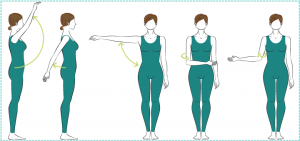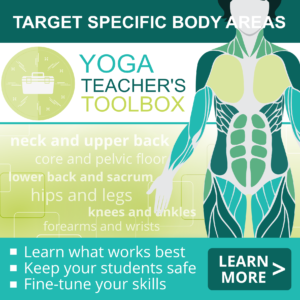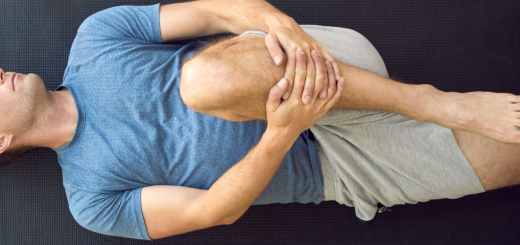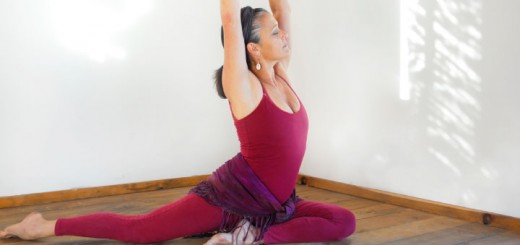
Whenever you plan to work with shoulders in your yoga class or private yoga session, it helps to remember the following important points:
- In our daily lives we rotate our shoulders internally constantly which can lead to shoulder imbalance and pain. It is useful to work on external shoulder rotation in your yoga classes to counterbalance that tendency.
- The arm does not function in isolation. The whole structure is called “the shoulder girdle” and it includes the arm, clavicle (collar bone) and scapula (shoulder blade). All these structures are meant to work together. We need to increase students’ awareness of those structures and teach them how to control their movement.
- Both pectoralis major (chest muscles) and latissimus dorsi (back muscles) attach at the anterior (front surface) of the arm bone. This means that when your chest OR upper back muscles are tight, they will try to rotate your arm internally. That is why when you deal with shoulder issues it is not enough to just stretch the chest (as we often see), but also to release tension in your lats.
- Isolated shoulder stretches are not very effective, because the movement of the shoulder needs to be organically linked to the rest of the body, specifically the movement of the spine, so that the complex network of muscles that connects the shoulder girdle to the spine and ribcage gets alternately stretched and strengthened.
- The shoulder often ends up on the receiving end of what’s happening elsewhere in the body; namely the chest, upper and middle back. That is why we need to restore balance around the shoulder girdle first by strengthening what’s weak and releasing chronic muscular tension.
- In real life we rarely do “pure” anatomical movements (ex: pure flexion or pure extension). We usually move the arms along complex trajectories that involve different combinations of more basic motions. That’s why when we attempt to “loosen up the shoulders” it makes sense to do more complex, integrative movements.
- Your shoulder is not a weight-bearing joint. This means that asking your shoulders to bear weight might be useful for the purpose of muscle strengthening or even improving bone density, BUT they are not equipped to handle prolonged or repetitive weight bearing activities.
- Our shoulder joints are prone to cumulative stress, which is usually due to repetitive tasks, mechanical compression and sustained/awkward positions. That is why multiple Chaturanga – Downward facing dog – Plank combos can strain and injure our shoulders if we are not careful about form, compensation and speed of movement.
Read more about these points in the posts below.
Sequence Wiz blog posts about shoulders and upper back
Get your shoulders out of the box
When yoga teachers decide to work specifically with shoulders in their yoga classes, they often either strain the shoulders too much with weight bearing poses, or do more of the same internal shoulder rotation that we overdo in our daily lives already. Here are some movements that would be more helpful. Read more >
Three ways to protect your shoulders in your daily life and yoga practice
All athletes know that if we rely on our arms to generate any kind of significant force, we are risking shoulder strain, pain and potentially dislocation.
This is just as relevant in our daily lives. Whether you drag your heavy suitcase at the airport, pull to open a heavy door or lift your kid, you are risking shoulder strain if you are not mindful about where the movement is coming from. Here are three basic ideas on how to protect your shoulders in your daily life and in your yoga practice.
One simple move to loosen up your shoulders
There are many suggestions on the internet on how to “loosen up the shoulders”; here is one move that brings your shoulder through the full range of motion. Read more >
Want pain-free shoulders? Cut down on your Downward dogs and Planks
In our quest for “power” we sometimes can take a yoga practice a bit too far and create shoulder problems for our students. There are several potential issues that can show up and here is why. Read more >
Sample yoga practices
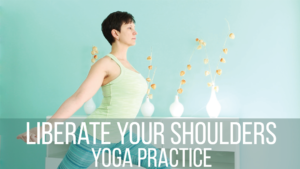 |
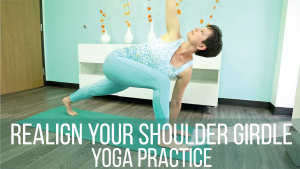 |
 |
Sample case study
![]()
Sequence Wiz members get access to unique client assessment forms and case studies. There is a case study of my former client Wendy who was looking to relieve persistent pain in her left shoulder. She was a puppeteer and animator who spent a lot of time leaning over her work table rearranging puppets. She loved her job but was worried that she was slouching too much. She also liked to swim, to go to yoga classes and had recently decided to try ballet, but her shoulder pain was interfering with all those activities.
Sequence Wiz members get access to records of our work together over five sessions (including the evaluation session). At the end of the month Wendy’s pain was mostly gone. You can find those files on your Sequence Wiz account under FORMS AND HANDOUTS > Sample forms and case studies.

Learn more about Sequence Wiz yoga sequence builder >
As yoga teachers, we want to help our students feel better in their bodies. This means that often we need to work with specific areas of tension and imbalance. What does it take to create an effective practice to release tension and increase range of motion in a particular part of the body? Some principles are universal, and some are unique to the target area. Here are some ideas on how you can approach it in your yoga classes, as well as some safety precautions that we need to consider. Check it out >
[jetpack_subscription_form]



